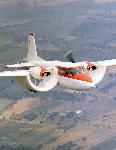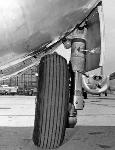Фотографии
-
Регистрационный номер: N6257C [2] Unconventional wisdom - Willard Custer’s peculiar but proven channel-wing concept aircraft, the CCW-5.
Самолёты на фотографии: Custer CCW-5 - США - 1953
-
Регистрационный номер: N6257C [2] The prototype five-seater CCW-5, N6257C, up from Custer’s base at Hagerstown Municipal Airport in the summer of 1953, shortly after its maiden flight that July. Modifications were made to the prototype during the test programme, including extending the forward edge of the nacelles and reducing the diameter of their cooling inlets.
Самолёты на фотографии: Custer CCW-5 - США - 1953
-
Регистрационный номер: N5855V [8] Production CCW-5 N5855V comes in for a landing at Hagerstown in 1964. In September that year Kevin Brown, Editor of Popular Mechanics, flew the aircraft: “As the ’plane loses speed, the nose comes up to hold altitude, and power is put back on. It’s like releasing the clutch and applying the accelerator in a stick-shift auto”.
Самолёты на фотографии: Custer CCW-5 - США - 1953
-
Регистрационный номер: N5855V [8] The one and only production CCW-5 in its final iteration, with a revised higher position for the tailplane and a taller fin. Along with the CCW-1, this aircraft also survives today and is under long-term restoration at the Mid-Atlantic Air Museum in Reading, Pennsylvania.
Самолёты на фотографии: Custer CCW-5 - США - 1953
-
Регистрационный номер: N5855V [8] The doggedly determined Willard Ray Custer beside the final iteration of the sole production Custer Channel Wing CCW-5 in the mid-1960s.
Самолёты на фотографии: Custer CCW-5 - США - 1953
-
Регистрационный номер: N5855V [8] The starboard channel wing and Continental engine of the first - and only - production CCW-5, N5855V. The channel incorporated a NACA 4418 aerofoil from the root to just outboard of the channel, and the outer wings were of NACA 4412 section.
Самолёты на фотографии: Custer CCW-5 - США - 1953
-
Регистрационный номер: N5855V [8] The nosewheel retracted forward and was fitted with a Goodyear 6-00 x 6 tyre (6in wide on a 6in-diameter wheel).
Самолёты на фотографии: Custer CCW-5 - США - 1953
-
Регистрационный номер: N5855V [8] The short 6-50 x 10 mainwheels retracted into the outer surfaces of the channels, the wheels being exposed and standing slightly proud of the channels.
Самолёты на фотографии: Custer CCW-5 - США - 1953
-
Регистрационный номер: N5855V [8] The rear of the port channel; both channels were more slender on the production example in order to reduce drag. Note how closely the propeller skims the channel’s trailing edge.
Самолёты на фотографии: Custer CCW-5 - США - 1953
-
Регистрационный номер: N5855V [8] The dual-control cockpit of the CCW-5 was laid out conventionally, with no additional controls or instruments.
Самолёты на фотографии: Custer CCW-5 - США - 1953
-
Самолёты на фотографии: Custer CCW-5 - США - 1953
-
Регистрационный номер: NX30090 [4] Custer’s first full-size aircraft, the CCW-1 is seen here under construction in the inventor’s laboratory/workshop/office in Hagerstown, Maryland, in 1942. Never one to make life easy for himself, master woodworker Custer created a sophisticated, streamlined ovoid fuselage from spruce and mahogany plywood.
Самолёты на фотографии: Custer CCW-1 - США - 1942
-
Регистрационный номер: NX30090 [4] A poor-quality but rare photograph of the CCW-1 during its military trials at Beltsville in 1943. Note the 10° dihedral at which the wings are set. Registered NX30090, the dark-blue CCW-1 survives today and is stored at the Paul E. Garber Preservation, Restoration & Storage Facility in Maryland, part of the National Air & Space Museum.
Самолёты на фотографии: Custer CCW-1 - США - 1942
-
Регистрационный номер: NX30090 [4] The CCW-1's original empennage, with vestigial tailfins plus rudder, and low-aspect-ratio tailplane with a single-piece elevator. This arrangement was later replaced with a boxkite-type tail during military trials at Beltsville in 1943, although the original was reinstated after the trials.
Самолёты на фотографии: Custer CCW-1 - США - 1942
-
Регистрационный номер: NX30090 [4] Custer clearly saw the channel wing as applicable to any type of aircraft, and used this model of a channel-wing-equipped twin-engined fighter-type to promote the concept. The model is seen here with just its channel wings fitted, but another model incorporated a larger wing with outer sections and a solid halfchord inner section.
Самолёты на фотографии: Custer CCW-1 - США - 1942
-
The cover of the May 1947 issue of Popular Mechanics, featuring the CCW-1 and ‘‘the wing that fooled the experts".
Самолёты на фотографии: Custer CCW-1 - США - 1942
-
Самолёты на фотографии: Custer CCW-1 - США - 1942
-
Регистрационный номер: N1375V [5] Willard Custer demonstrates the sucking effect of the pusher-configured propellers over the port channel of the as-yet-uncovered CCW-2 with a ribbon. When first reported in the UK, in the January 4, 1952, issue of Flight, the tenor of the article was mildly sceptical: “The claims made by the Custer Corporation are, to say the least, sweeping ..."
Самолёты на фотографии: Custer CCW-2 - США - 1948
-
Регистрационный номер: N1375V [5] The CCW-2, given the civil registration N1375V, mounted on a test stand in the windtunnel at NACA’s Langley Aeronautical Laboratory on May 8, 1952. By the time of the trials the diminutive CCW-2 had been modified with a taildragger undercarriage, the fuselage was covered and a small enclosed cockpit had been incorporated.
Самолёты на фотографии: Custer CCW-2 - США - 1948
-
Регистрационный номер: N1375V [5] President of Custer’s first company, the National Aircraft Corp, Frank D. Kelley sits at the controls of the startling CCW-2, Custer’s second full-size channel-wing aircraft, in 1948.
Самолёты на фотографии: Custer CCW-2 - США - 1948
-
Регистрационный номер: N1375V [5] Willard’s son Harold Custer at the controls of the CCW-2, built purely as an engineering testbed to conduct experiments with the channel wing. Based on the fuselage of a Taylorcraft lightplane, the CCW-2 is seen here without outer wing panels and with its original tricycle undercarriage, in which form it first flew in July 1948.
Самолёты на фотографии: Custer CCW-2 - США - 1948
-
Регистрационный номер: N1375V [5] With the windsock showing zero wind, the taildragger-configured CCW-2 pulls it tethers taut during a demonstration of its vertical-lift capabilities on December 7, 1951. Unfortunately for Custer, NACA’s testing of the aircraft at Langley the following year focused heavily on this aspect rather than its conventional STOL performance, for which it had been specifically designed.
Самолёты на фотографии: Custer CCW-2 - США - 1948
Статьи
- -
- D.Gordon - Spies in Cold War Skies
- G.Alegi - Macchi's Sky Scooter
- J.Franzi - To Hell and Back... /An eye for detail/
- J.Stroud - An Englishman in New York /The John Stroud Archive/
- K.Hayward - Trident. Britain's Fork in the Road?
- K.Honey - In the Land of Black Gold
- N.Mathisrud - The Other Stockholm Run
- N.Stroud - Willard Custer & the Channel Wing
- P.Davidson - Off the Beaten Track...
- P.Jarrett - Lost & Found
- R.Paver - Black on Wight
- T.Cooper - ...Blaaaam! Six dramatic minutes over Angola
- T.Oliver - Hands Across the Water?
- W.Robinson - The Reluctant Overnight Hero





















